In the beginning…
The Princeton First Aid & Rescue Squad had its beginnings in early 1938 with the formation of a first aid committee by Princeton Engine Company No.1. Chaired by John J. Golden, the committee was charged with establishing a first aid training program. The initial series of instruction, organized by Elmer Rodweller, was led by Dr. Roger Evan and began on January 11, 1939. More than 40 members of the Princeton Fire and Police Departments along with employees of the Princeton University Physical Plant were trained in first aid procedures by William Sandhoff, Joseph Herrity and Frank Piffath.
On April 29, 1939, the First Aid Unit of Princeton Engine Company No.1 was formed officially. Headquartered in the Chestnut Street firehouse, it operated out of a station wagon stocked with first aid supplies donated by Johnson & Johnson. Financial assistance was provided by the Fire Company and local residents.
In March 1940, the Princeton Engine Company No. 1 First Aid Unit was incorporated with John J. Golden serving as the first president. That July, the First Aid Unit joined the New Jersey State First Aid Council, becoming that organization’s 80th member squad. The Unit’s first ambulance, a 1941 Cadillac, was purchased the following year at a cost of $3,500. The new ambulance made its debut at the annual July 4th fireworks display at Palmer Stadium. Following the vehicle’s commissioning, First Aid Unit members began sleeping in at the firehouse to ensure the availability of prompt, 24-hour coverage for the greater Princeton area. Shortly thereafter, ambulance services that had been offered by local funeral directors (Ralph E. Kimble and Southard S. Mather) were discontinued. Those services – provided out of necessity – charged patients up to $5 for a trip to the hospital.
Declining membership through the war years prompted the First Aid Unit to open its ranks to individuals outside of Engine Company No. 1. In 1941, Albert Toto became the first non-firefighter member of the First Aid Unit. Emergency calls continued to rise and the purchase of additional equipment became necessary. By September, the First Aid Unit had responded to 30 calls, driven 400 miles, and logged 70 man-hours. The number of calls grew to 85 by November and continued to grow into the next year with the First Aid Unit responding to 279 calls and traveling 4,089 miles in 1942.
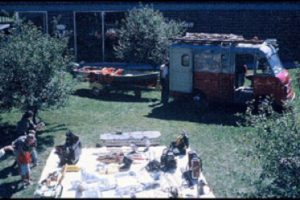 Contributions from residents, businesses, and civic groups was the primary means of financing equipment purchases and associated maintenance costs. The first fund-raising effort in 1941 brought in $4,200. By 1951, the original ambulance had to be replaced and a Packard ambulance was purchased from John Sylvester at a cost of $7,345. In that year, the First Aid Unit responded to 534 calls for service and its members contributed 1,362
Contributions from residents, businesses, and civic groups was the primary means of financing equipment purchases and associated maintenance costs. The first fund-raising effort in 1941 brought in $4,200. By 1951, the original ambulance had to be replaced and a Packard ambulance was purchased from John Sylvester at a cost of $7,345. In that year, the First Aid Unit responded to 534 calls for service and its members contributed 1,362 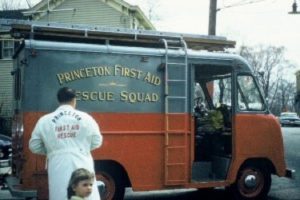 Following the tragic drowning of Township Patrolman Billie D. Ellis on Lake Carnegie in August of 1955, the Lions Club of Princeton donated a fourteen-foot boat, trailer and water rescue/recovery equipment. A year later, 26 Princeton residents, led by H. C. Sturhahn, donated a fully-equipped Ford Stand-Up van. Dedicated on April 18, 1957, the van became the First Aid Unit’s first rescue truck.
Following the tragic drowning of Township Patrolman Billie D. Ellis on Lake Carnegie in August of 1955, the Lions Club of Princeton donated a fourteen-foot boat, trailer and water rescue/recovery equipment. A year later, 26 Princeton residents, led by H. C. Sturhahn, donated a fully-equipped Ford Stand-Up van. Dedicated on April 18, 1957, the van became the First Aid Unit’s first rescue truck.
On May 20, 1957, the First Aid Unit was renamed the Princeton First Aid & Rescue Squad, Inc., and became one of the first rescue units in the State of New Jersey.
In May of 1960, the Princeton First Aid & Rescue Squad ad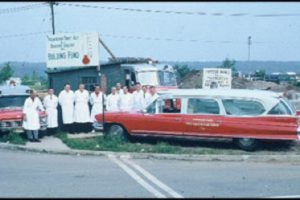 ded a custom-built Lincoln ambulance to its fleet. The vehicle, purchased from Nassau-Conover Ford and manufactured by the Ford Motor Company, was a prototype for future ambulance manufacturing. However, it was replaced in 1962 by a Cadillac because of extensive electrical problems. In August 1960, the Ladies’ Auxiliary of the Princeton First Aid & Rescue Squad was incorporated. The auxiliary helped the Squad with logistical support on protracted calls and raised money to offset operational costs.
ded a custom-built Lincoln ambulance to its fleet. The vehicle, purchased from Nassau-Conover Ford and manufactured by the Ford Motor Company, was a prototype for future ambulance manufacturing. However, it was replaced in 1962 by a Cadillac because of extensive electrical problems. In August 1960, the Ladies’ Auxiliary of the Princeton First Aid & Rescue Squad was incorporated. The auxiliary helped the Squad with logistical support on protracted calls and raised money to offset operational costs.
Additional equipment acquisitions necessitated a larger facility, so in 1961, the Squad purchased land for a new building at the corner of Clearview Avenue and North Harrison Street. Contracts were signed in 1962 with the Lewis C. Bowers Construction Company, construction began. In May of 1963, the Princeton First Aid & Rescue Squad left Engine Company No. 1 and moved into its new headquarters. The building was dedicated on April 12, 1964, and a $75,000 Building Fund Drive was achieved.
As the population of surrounding areas grew, the Princeton squad answered calls within a 100-square mile area, covering Princeton, Kingston, Kendall Park, Plainsboro, and parts of East Windsor, West Windsor, Lawrence and Montgomery Townships. Eventually, surrounding towns established their own first aid squads.
A new $35,000 rescue truck, custom built by Swab Wagon Company, was dedicated on October 1, 1969, and replaced the 1957 Ford Stand-Up Van.
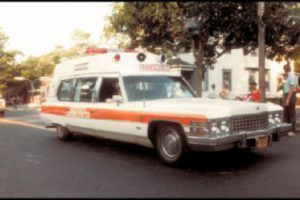 In 1970, The Squad purchased the first modular-type ambulance manufactured by Swab Wagon Company. This new ambulance design significantly increased the storage and workspace in the back of the vehicle. The improvements in patient care and rescue worker safety afforded by this design soon made it an industry standard.
In 1970, The Squad purchased the first modular-type ambulance manufactured by Swab Wagon Company. This new ambulance design significantly increased the storage and workspace in the back of the vehicle. The improvements in patient care and rescue worker safety afforded by this design soon made it an industry standard.
In 1974, a Chevrolet Blazer four-wheel drive vehicle was added to the fleet. As the equipment inventory and number of vehicles grew to meet the increasing demand of the Princeton community, the Squad contracted with Boice-Steward Construction Company to build an addition to its headquarters. The 1974 project added a larger bay to house the rescue truck and marked the last expansion to the building.
In 1976, Pat Bodine, Antonia Bogart, and Suzanne Neilson became the first female members of the Princeton First Aid & Rescue Squad. In 1977, the Life Mobile Program was activated, establishing the Squad as an Advanced Life Support (ALS) provider. J. Edwin Obert, Jr., the Squad’s first volunteer paramedic, was on the first advanced life support (ALS) call in November 1977.
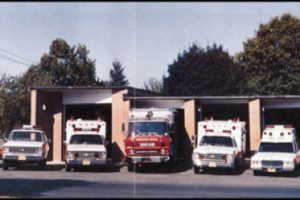 In March of 1980, the Squad purchased another ambulance (G. M. Wolf Modular) for $47,000, bringing the total number to three. Limited availability of volunteer members to respond to daytime calls prompted the creation of a compensated career EMT day crew on May 4, 1980. Diran Dermen and Tom Krisanda became the first full-time employees of the Squad. The municipally-funded day crew program guaranteed ambulance coverage for the Princeton community, an issue that had concerned the Squad since its inception. The program was made possible through the efforts of Squad members (led by Mark Freda and J. Edwin Obert, Jr.), the Joint First Aid Committee (Squad members, Borough and Township elected officials and local citizens), the Princeton Medical Center and other concerned citizens. Increasing numbers of calls and miles driven by the Life Mobile necessitated its replacement in 1984 with a third modular-type G. M. ambulance purchased from East Coast Emergency Vehicle Builders, Inc. at a cost of $52,000.
In March of 1980, the Squad purchased another ambulance (G. M. Wolf Modular) for $47,000, bringing the total number to three. Limited availability of volunteer members to respond to daytime calls prompted the creation of a compensated career EMT day crew on May 4, 1980. Diran Dermen and Tom Krisanda became the first full-time employees of the Squad. The municipally-funded day crew program guaranteed ambulance coverage for the Princeton community, an issue that had concerned the Squad since its inception. The program was made possible through the efforts of Squad members (led by Mark Freda and J. Edwin Obert, Jr.), the Joint First Aid Committee (Squad members, Borough and Township elected officials and local citizens), the Princeton Medical Center and other concerned citizens. Increasing numbers of calls and miles driven by the Life Mobile necessitated its replacement in 1984 with a third modular-type G. M. ambulance purchased from East Coast Emergency Vehicle Builders, Inc. at a cost of $52,000.
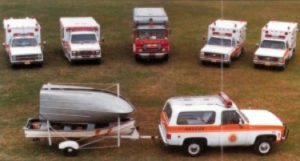 Adoption of the county-wide paid paramedic program in 1985 resulted in a decline in the number of ALS calls received by the Squad, and an eventual return over the next two years to only Basic Life Support (BLS) care. During that same period, the Squad met the State’s enhanced training standards by certifying its riding members as Emergency Medical Technicians (EMTs).
Adoption of the county-wide paid paramedic program in 1985 resulted in a decline in the number of ALS calls received by the Squad, and an eventual return over the next two years to only Basic Life Support (BLS) care. During that same period, the Squad met the State’s enhanced training standards by certifying its riding members as Emergency Medical Technicians (EMTs).
The fleet replacements occurred in 1988, with the acquisition of a $61,000 modular ambulance from P. L. Custom Body, and a $9,000 Zodiac inflatable pontoon boat with a 30HP motor.
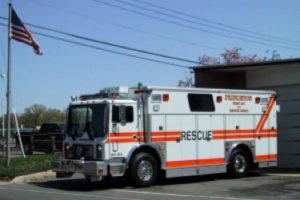 In 1991 the Squad replaced the Swab rescue truck with a Mack MR vehicle custom built by PL Custom Body. The new rescue truck was designed to be a self-sufficient unit carrying a command and dispatch center, equipment for vehicle extrication, confined space rescue, ice and water rescue, fire ground support, air bottle filling and a 6,000-watt light tower.
In 1991 the Squad replaced the Swab rescue truck with a Mack MR vehicle custom built by PL Custom Body. The new rescue truck was designed to be a self-sufficient unit carrying a command and dispatch center, equipment for vehicle extrication, confined space rescue, ice and water rescue, fire ground support, air bottle filling and a 6,000-watt light tower.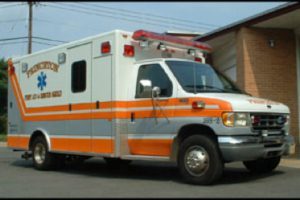
Additional changes to State protocols allowed the Squad to be trained to carry cardiac defibrillators (previously only an ALS skill). On April 29, 1993 at 2:23 in the afternoon, the Day Crew and five volunteer members responded to a call for a “possible heart attack” in Palmer Square. On that call, they became the second BLS crew in New Jersey to save a life using the new defibrillators. That patient walked out of the hospital two weeks later. Since that time, the Squad has carried defibrillators on all of its apparatus.
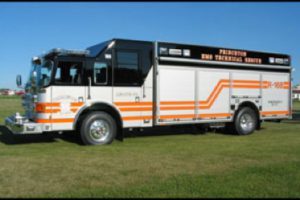 In 2001, Princeton University donated an American LaFrance MedicMaster ambulance built on a Freightliner truck chassis. The ambulance it replaced was converted to a Special Services unit to carry equipment for Mass Casualty Incidents, and provide personnel rehabilitation at fire scenes and other large-scale responses. That same year, the Squad replaced its water rescue craft with a Zodiac inflatable boat, 50 horsepower motor and rapid deployment trailer for $12,500. In 2002 the first response vehicle was replaced by another former police car, and a year later the Mack rescue truck was replaced with a safer, larger Pierce Enforcer Stainless Steel Rescue Truck for $430,000.
In 2001, Princeton University donated an American LaFrance MedicMaster ambulance built on a Freightliner truck chassis. The ambulance it replaced was converted to a Special Services unit to carry equipment for Mass Casualty Incidents, and provide personnel rehabilitation at fire scenes and other large-scale responses. That same year, the Squad replaced its water rescue craft with a Zodiac inflatable boat, 50 horsepower motor and rapid deployment trailer for $12,500. In 2002 the first response vehicle was replaced by another former police car, and a year later the Mack rescue truck was replaced with a safer, larger Pierce Enforcer Stainless Steel Rescue Truck for $430,000.
PFARS began hosting EMT-Basic training courses in 2003. New members trained through this class have found they are more quickly able to orient themselves to Squad operations and earn promotions within our system. The year 2003 marked the first time the call volume surpassed 2,000, as the Squad answered 2,113 calls for service.
In order to meet its growing operating budget, the Squad began billing patients’ insurance carriers in January 2006. At the same time, Princeton Borough and Township capped their contributions to the Squad that had defrayed the cost of paying day crews, reduced them further in 2009, and subsequently stopped contributing to Squad operations.
 With a multi-year trend of call volume increasing at 10% per year, changes to the Squad Day Crew program were needed. In 2007, a third paid day crew member was added, extending the day crew schedule from 7 a.m. to 7 p.m. Faced with increased demands on the time of its volunteer officers to run the organization, the Squad hired a paid Director of Operations in January, 2007. The first (and current) Director of Operations is Frank Setnicky, a 30-year member of the squad. With call volumes continuing to rise, the Squad added a second day crew in July 2008, bringing to five the number of full-time EMTs.
With a multi-year trend of call volume increasing at 10% per year, changes to the Squad Day Crew program were needed. In 2007, a third paid day crew member was added, extending the day crew schedule from 7 a.m. to 7 p.m. Faced with increased demands on the time of its volunteer officers to run the organization, the Squad hired a paid Director of Operations in January, 2007. The first (and current) Director of Operations is Frank Setnicky, a 30-year member of the squad. With call volumes continuing to rise, the Squad added a second day crew in July 2008, bringing to five the number of full-time EMTs.
On April 28, 2007, the Squad became the first basic life support agency in New Jersey to use a non-prescribed auto-injecting epinephrine syringe (“Epi Pen®”) to save the life of a two-year-old boy who had a severe allergic reaction to peanuts. The call took place just eight days after the Princeton First Aid & Rescue Squad became one of the first agencies in the state authorized to carry the devices.
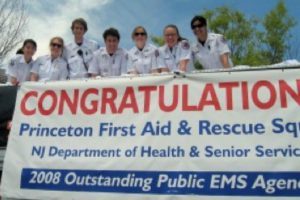 In 2008, the Squad replaced two of its ambulances with new ones built on a Ford chassis by Horton Emergency Vehicles. The combined cost for the vehicles was $335,789.
In 2008, the Squad replaced two of its ambulances with new ones built on a Ford chassis by Horton Emergency Vehicles. The combined cost for the vehicles was $335,789.
Also in 2008, the Squad was named Outstanding Public EMS Agency by the New Jersey Department of Health and Senior Services, Office of Emergency Medical Services. The Squad was recognized for its extensive training program, dedicated personnel, and capabilities in emergency medical and technical rescue services.
Today, the Princeton First Aid & Rescue Squad membership consists of more than 90 individuals from many walks of life. To ensure the delivery of rapid and skillful emergency medical care, crews are scheduled in the station 24 hours a day, 7 days a week with off-duty members available by pager to respond to additional or large-scale incidents.
The current fleet of apparatus includes four modular ambulances, a technical rescue truck, a four-wheel drive utility vehicle, an eight-man Zodiac boat, a special services and rehab vehicle and a first-response car.
As the demand for services grows, so too must the organization. the Squad is actively working to secure property for a new headquarters. Plans are underway to finance and construct a new, desperately-needed facility. The members of the first aid squad are optimistic that the community will respond to its need for support just as it has for the past 70 years.
Though the apparatus and individuals have changed, our goal remains the same – serving the Princeton community with the highest quality of emergency medical and technical rescue services. It is only through the efforts of generations of capable members and the support of a grateful community that our Squad is able to celebrate such a proud history.
The charter of the Ladies Auxiliary is to support the Princeton First Aid & Rescue Squad in its mission. Today, much of that support is through fund raising.
The Auxiliary started in simpler times when fire and rescue services were provided by a volunteer fire department (Engine Company No. 1), all of whom were male. Some calls, like fires, rescues and search operations, were longer and more difficult than others, and so the wives of the volunteers began to accompany their husbands on “long calls” to provide liquids and food. They also made cravats (triangular bandages used temporarily for a fracture or wound) for the responders.
Engine Company No. 1’s Rescue Unit was formally incorporated as a separate entity (and renamed Princeton First Aid & Rescue Squad) in 1957. Three years later in 1960, the Ladies Auxiliary also became a formally incorporated organization and continued to provide on-call support.
As the state’s educational and training standards became more rigorous and the population growth demanded round-the-clock response, the Squad came to rely on highly-trained volunteers and career staff members to meet service demands. In line with these changes, the Auxiliary altered its focus from support on “long calls” and bandage-making to fund raising, allowing the first aid squad to purchase medical equipment (such as defibrillators), uniforms, and amenities for the Squad building.



